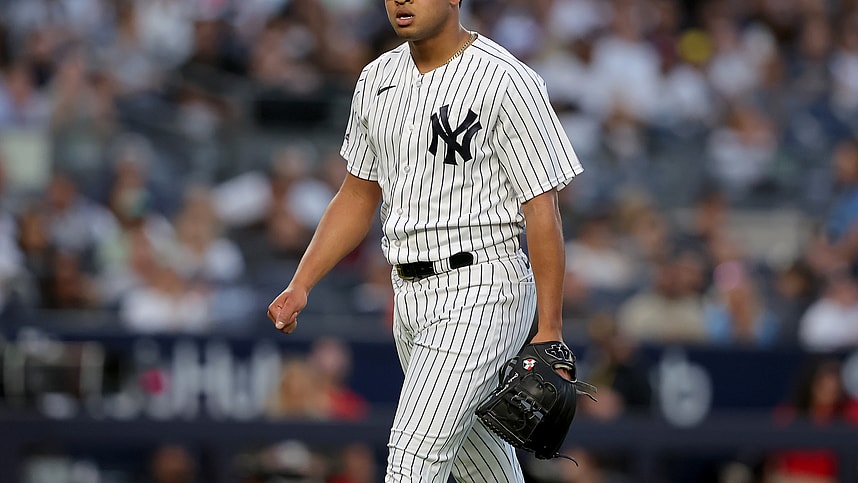
Luis Severino isn’t the pitcher he once was, as the dropoff from last season has been staggering. With his pitch quality and shapes worsening coming as he enters free agency in the winter, the Yankees likely aren’t retaining the former All-Star. It’s a sad decline to see, especially after seeing the heights he once reached in 2017 and 2018, just to flash signs of that greatness during the 2022 season.
With that being said, the Yankees can’t reminisce on the past for much longer, and they’ll need to figure out who can fill in as the fifth starter for the remainder of the season. The Yankees are battling to try to climb into the postseason and while a rookie comes with volatility, it’s certainly better than what Luis Severino has given them thus far. With that being said, the Yankees have a name on their 40-Man Roster who could step up as their fifth starter as they navigate through the final months of the season.
Randy Vásquez may not have as much Triple-A experience as the Yankees would like, but his excellent and diverse pitch arsenal creates a high-upside arm that could flourish with MLB development. We’ve seen him in brief stints already, but the Yankees should deploy him as a full-time member of their rotation.
- Yankees News & Buzz: Yanks running out of time but still have options; Tatsuya Imai dream might be fading, more
- Luke Weaver bids farewell to Yankees fans with heartfelt letter
- The Yankees are short on time, but not short on options
Some of the Best Pitch Shapes in the Yankees’ Organization
The Yankees are above .500 despite the mayhem on social media regarding the team, and that’s all because of their pitching and Aaron Judge, but let’s stick to pitching. One area of the team that cannot be questioned is the one largely covered by Sam Briend and Matt Blake, two of the best hires Brian Cashman has ever made in the Front Office. A team that once struggled to find arms, these two have helped the Yankees produce nasty arms from wherever in the organization.
One of those nasty arms from their farm system is the 24-year-old right-hander out of the Dominican Republic, Randy Vásquez. He really popped onto the prospect scene following a ridiculous 2021 season where his sweeping breaking ball just dominated hitters in the lower levels of Minor League Baseball. Striking out 28.6% of batters faced with a 2.52 ERA in 107.1 IP, the righty would break out breaking pitches that could register over 3,000 RPMs of spin.
He’s battled through Double-A and Triple-A over the past two seasons, and while he got off to an extremely shaky start in the run-heavy International League, he’s settled into a great role in the Scranton rotation. Over his last 11 starts, he’s pitched to a 3.67 ERA and 3.91 FIP, striking out 27% of batters faced and logging a 16.7% K-BB%. While his command is shaky, there’s no doubt about the upside of his pitch mix and stuff.
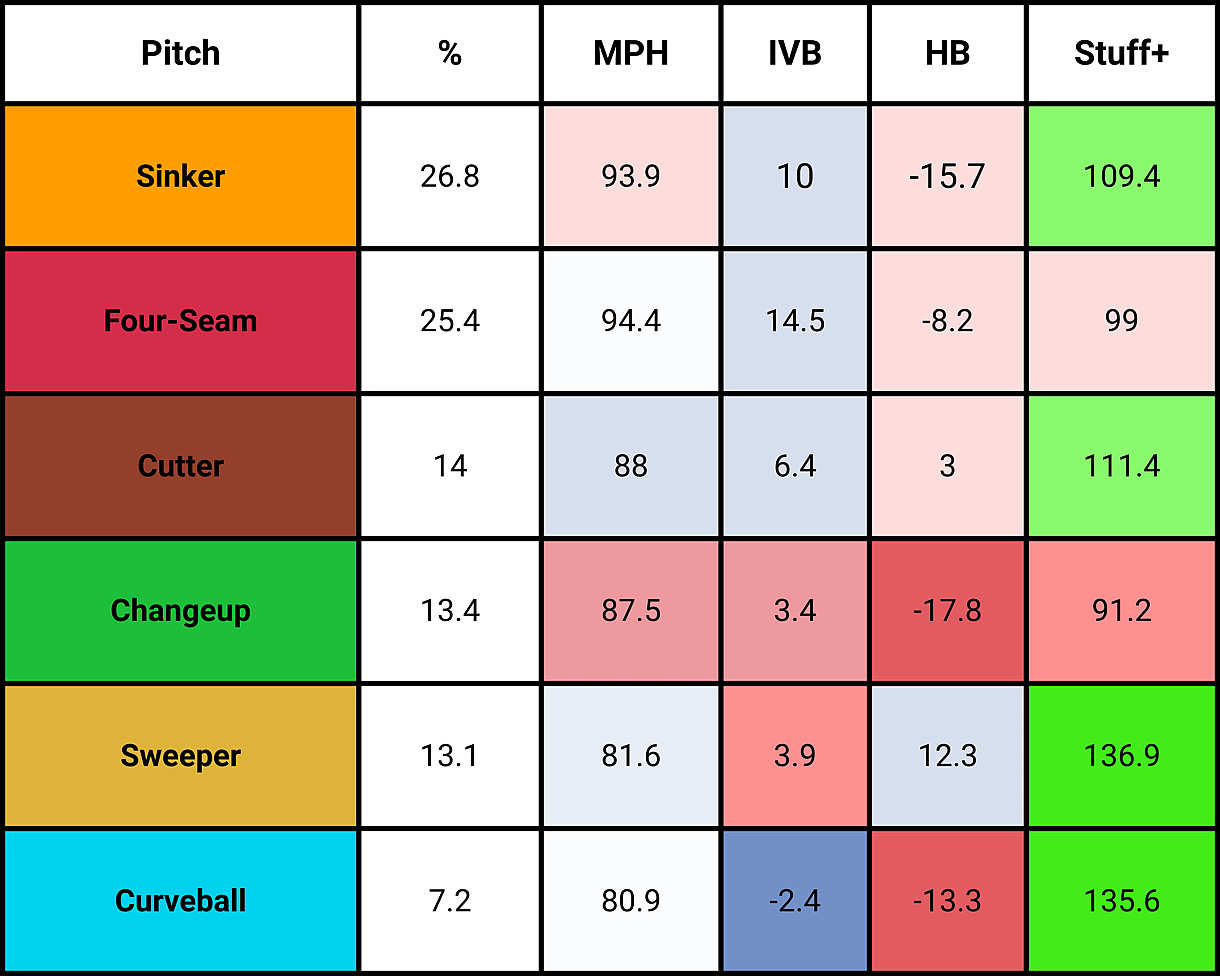
First, let’s explain the graph we’re looking at, trust me, it’s not as complex as it may look.
The first column is our pitch classification, separating each pitch he throws to allow us to isolate and identify pitch selection and movement profiles. As for the second column, that’s the frequency Vásquez uses said pitch, and based on his Triple-A data, he doesn’t overly rely on one given pitch relative to the rest. The third column is velocity, which plays into the final column that we’ll get to in a bit.
Columns four and five measure short-form movement, which is the movement of a pitch without the effects of gravity, although the effects of gravity only tend to affect a pitch’s vertical break. IVB stands for Induced Vertical Break, and more vertical break signifies more movement up in the strike zone, whereas if you get closer to zero or even into the negatives, your pitch will play better in the lower quadrants of the zone.
HB is just Horizontal Break, which allows us to measure the movement of a pitch laterally. For right-handers, negative is arm side movement (into a righty, away from a lefty), and positive is glove side movement (away from a righty, into a lefty). Stuff+ takes into account velocity, movement, release point, and other various factors I’ve linked here that grade a pitch based merely on its “stuff” (thus the name Stuff+!).
You may notice strong grades on pitches that lack great movement, velocity, or both, so let’s use one of the highly-graded pitches to delve into what makes it so good. Vásquez has a nasty cutter that he’s used prominently in starts at the Major League level due to its ability to generate soft contact and act as a reliable weapon against left-handed hitters, who have consistently given him trouble in his professional career.
A pitch we really didn’t see him prominently use until this year, his cutter has fewer inches of induced vertical break than the average cutter, but it’s the deception of his arm slot that makes this pitch so gross. Among 94 pitchers who have thrown at least 100 cutters in 2023, he would have the sixth-widest release point for a cutter, creating a unique arm slot that most hitters won’t have familiarity with.
This also applies to all of his pitches, as his unique release point causes his pitches to release from a point that hitters aren’t trained for. This plays into a strong Stuff+, and with good tailing or sweeping action on most of his pitches, he’s an arm that’s going to get a lot of ugly swings. While his strikeout rate is something that he’s seen fluctuate in the Minor Leagues, he’s upped the strikeout rate since adding that cutter, which bridges the large movement profiles between his sinker/changeup and sweeper/curveball.
The issue with his mix isn’t whether it can get hitters out but rather if Randy Vásquez can command his stuff well enough to have it play at a high level. Vásquez is capable of racking up strikeouts when he’s locating and mixing his pitches effectively, as over his previous five Triple-A starts, he’s struck out 31.1% of batters with a 2.45 ERA. It’s easy to fall in love with his breaking balls, as both pitches spin over 3,000 RPMs with wicked horizontal movement.
Randy Vásquez has always struggled with swinging strike rates, but this feels like a problem that has more to do with pitch selection rather than pitch quality. His sinker and four-seamer are not reliable swing-and-miss pitches that make up 52.2% of his pitches thrown in Triple-A. Perhaps he feels like he can’t reliably command his sweeper or curveball, but if he wants to have sustained success in the league, the ability to throw his breaking balls in-zone for strikes is crucial.
His sweeper and curveball usage is used 20.3% of the time despite being his best pitches by far, and they both have viability in select situations. While the league as a whole has improved against sweepers, righties still have a .253 wOBA and negative run value against sweepers from right-handed hitters. By increasing the usage of the pitch against righties, he could have a better time generating whiffs and sequencing as well, something the Yankees could look into.
Searching For Consistency in a Hectic International League
While his pitch shapes are stellar, the aforementioned command issues limit his ability to execute these nasty pitches consistently. If he’s not able to consistently land those pitches over the course of a start, he’ll likely find himself in the bullpen. Consistent mechanics are one thing, but in other cases, command issues are solved by tweaking pitch usage to better emphasize pitches that’ll generate more success.
It’s important to note a couple of things when we look at pitch data and performance, and that’s how the run environment is at that level. The Scranton RailRiders play in the International League, where the league-average ERA of 5.27 and OPS of .803 give hitters a distinct advantage at that level. For these reasons, we’re going to use charts with data that have reference points for the Triple-A league-average so that we can properly evaluate these numbers.
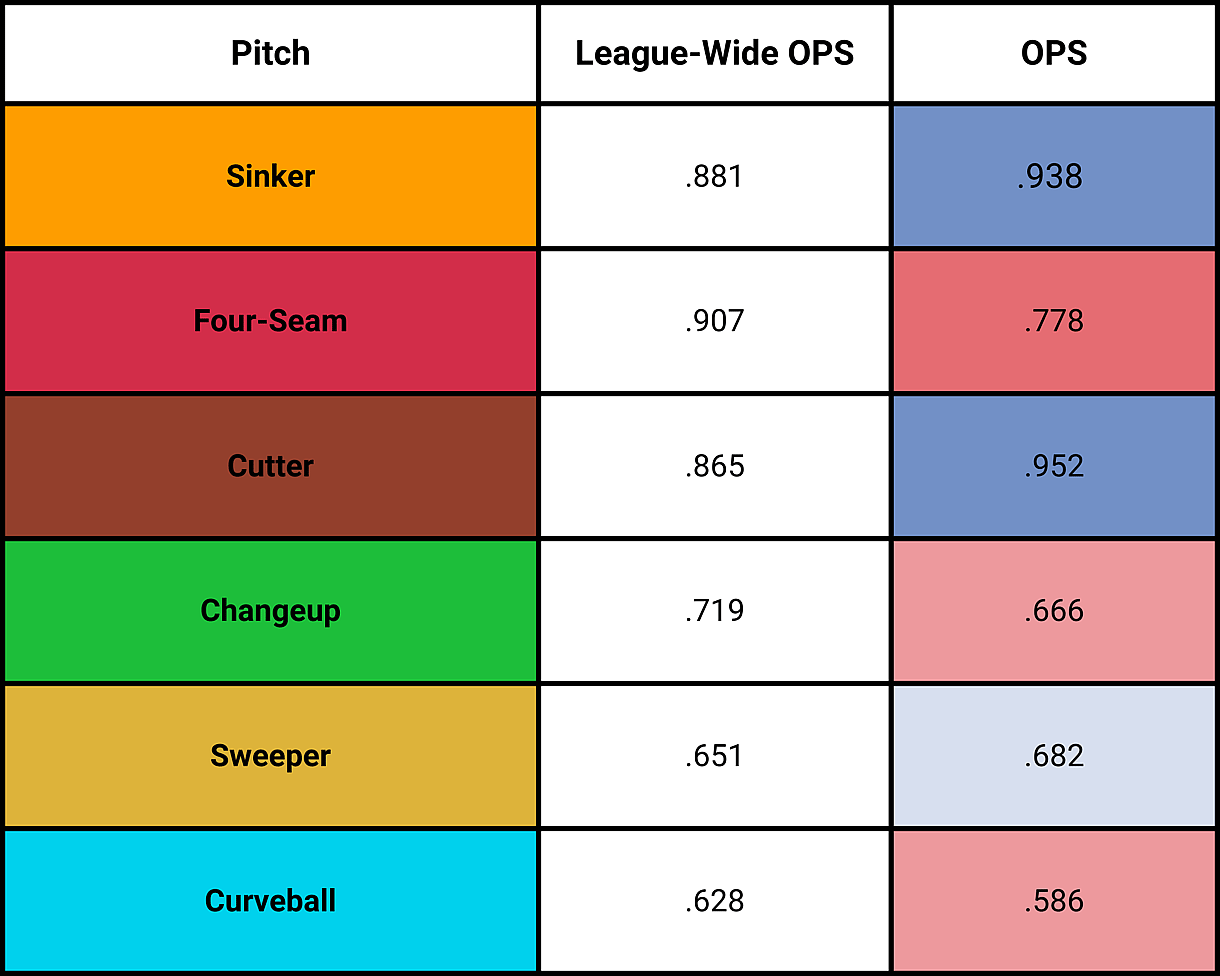
His best pitches on a performance basis (relative to the league) are his four-seam fastball, changeup, and curveball, which make sense since all of these pitches play well to left-handed batters, which Vásquez has held to an OPS under .710, while right-handed hitters have an OPS of .875 against him. This means his horizontal profiles aren’t working for right-handed hitters, and when we look at his pitch selection, we see his selection heavily favors his four-seamer and sinker, with the sweeper not heavily involved.
The Stuff+ on his sweeper is downright elite, although the Triple-A environment promotes more walks since the ball is flying and a mistake is easily turned into damage contact, and a hanging sweeper is a right-handed hitter’s dream. That being said, the baseball isn’t flying at that rate in the big leagues, and a pitch with elite-level shapes should be used a lot more frequently in a platoon advantage situation like this one.
His fastball-changeup-curveball set up elite vertical tunnels with large gaps in vertical separation, and it shows in the OPS numbers, although the most interesting pitch to me here is his cutter. I feel like this is a pitch that, with better command, could be a really good offering, however, improved results on the four-seamer could make it irrelevant. Sometimes, pitching is about ripping your best stuff, and for pitchers with great shapes and questionable command, it’s a viable strategy for a starter.
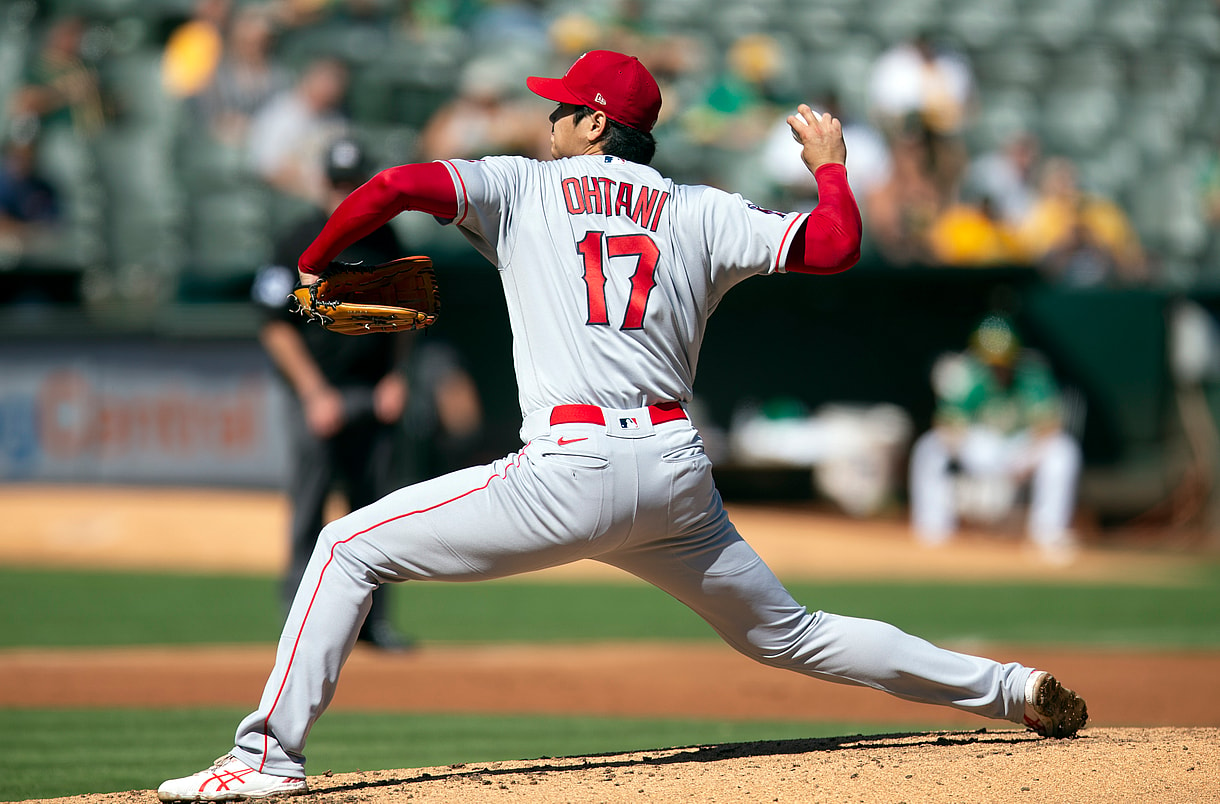
Shohei Ohtani is not just the 2023 AL MVP lock but also the best example of missing off the middle of the plate. Catchers will set up middle-middle for Ohtani when he delivers, as they anticipate the natural movement of the pitch to cause a miss off the middle of the plate and create chaos for batters. His elite stuff is so good he can just throw it down the middle and it’ll move off the plate for soft contact and whiffs, it’s truly wonderful to watch.
Vásquez doesn’t possess the upper-echelon level of Stuff that the likes of Ohtani have, but a similar mentality with his breaking pitches could result in better performances on the mound. We’ve seen Vásquez mix his pitches well, but an overreliance on fastball offerings that have given up a lot of damage, incorporating some of his elite-level pitches, and trying to miss off the middle of the plate could be the cues he needs in order to more reliably put away batters.
People underestimate how hard the run environment in Triple-A looks like, and with Vásquez continuously getting better as the season goes on, he’s quickly becoming one of the league’s better starters. The internal competition he has stems from his teammate at High-A, Double-A, and now Triple-A in the form of Jhony Brito, who has always been a step ahead of Vásquez on the depth chart.
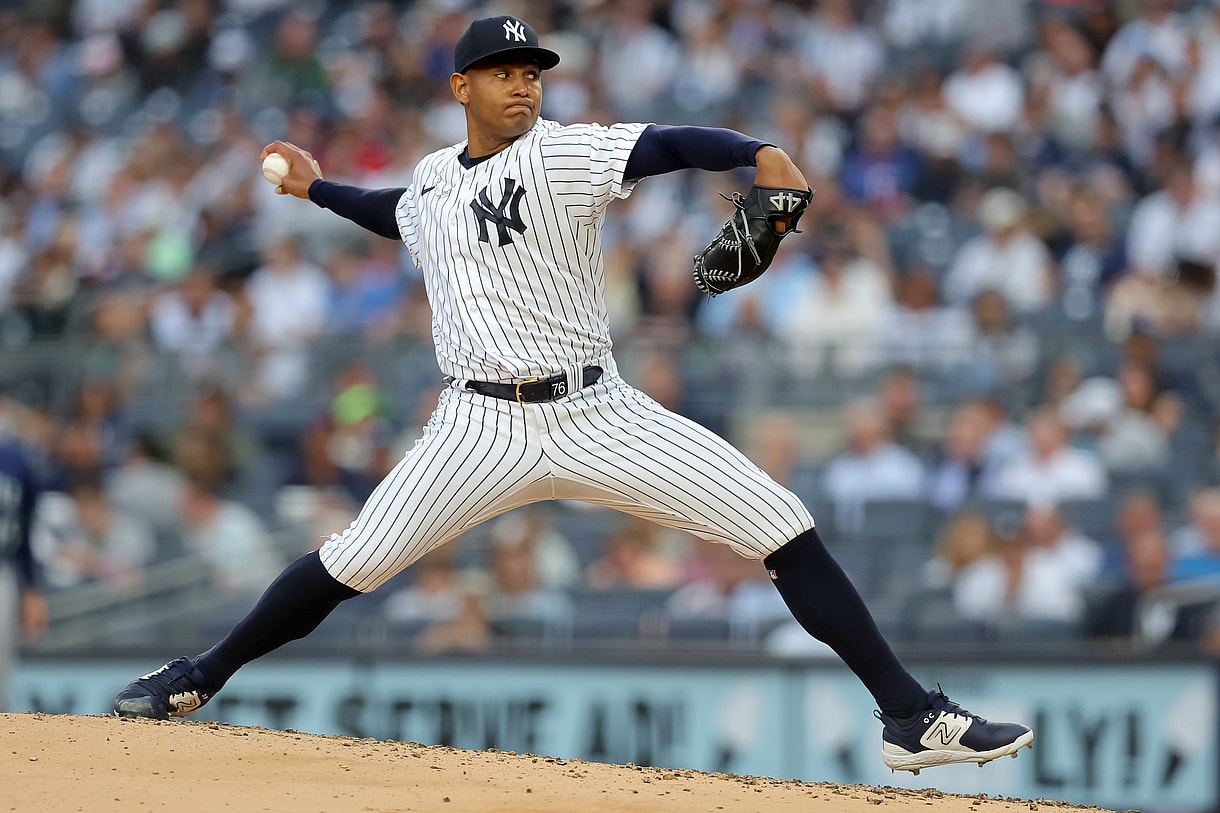
A year older than Vásquez at 25 years old, Brito has beaten him to the punch in terms of making a High-A, Double-A, Triple-A, and MLB debut. In Spring Training, injuries to Frankie Montas, Carlos Rodon, and Luis Severino forced the Yankees to utilize one of their rookie starters, and Jhony Brito won handily over Randy Vásquez, as while Brito had a 0 ERA in the Spring, the Yankees’ #12 Prospect according to MLB Pipeline struggled in multiple outings.
This year, however, the script has flipped on the two, and now Vásquez stands as the better-performing starter after Brito led the way in ERA at 3.56 since 2021. We’re going to compare Brito and Vásquez in three key statistics, measured up against the International League averages in those categories as well.
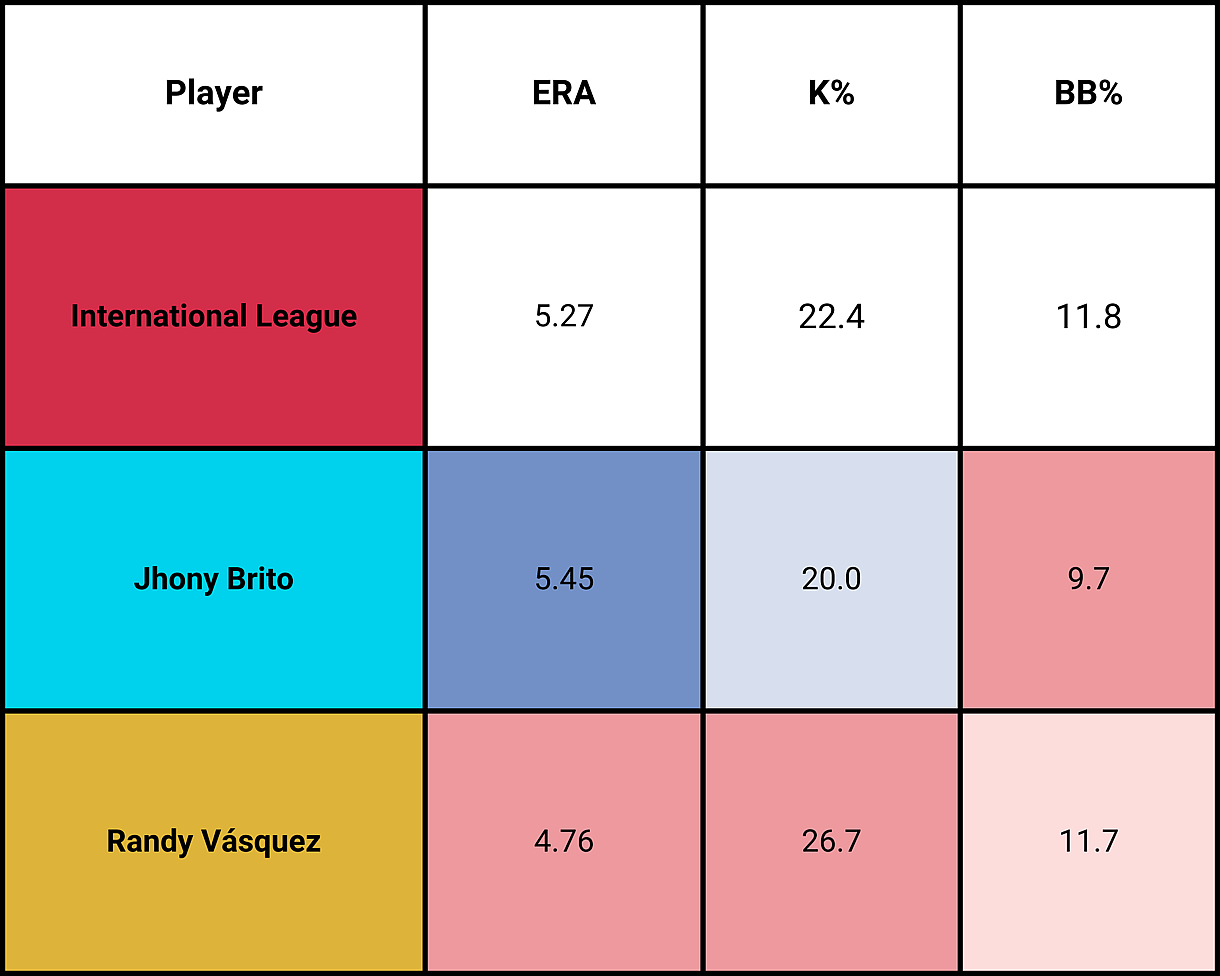
For all of his walks and misfires in pitch execution, he’s pitching much better than the league-average starter at his level. He’s gotten better as the season has gone on as if we look at different key dates, we see a progressing ERA and strikeout rate, with home runs going down as well. Randy Vásquez has slowly become one of the best starters for the Scranton Railriders, and that’s with Yankees’ #7 Prospect Will Warren in that rotation and the aforementioned Brito, who has been rock solid at every level of professional baseball.
- Since Opening Day (16 Starts): 4.76 ERA, 26.7% K%, 1.07 HR/9
- Since April 29th (11 Starts): 3.67 ERA, 27% K%, 0.67 HR/9
- Since June 20th (5 Starts): 2.45 ERA, 31.1% K%, 0.7 HR/9
Improving results with improving comfort on the mound and in a league where runs are easy to come by shows progression, and at each stage, he produced above-average strikeout and above-average strikeout-to-walk numbers as well. The big issue he’s had at Triple-A comes from the ability to pitch deep into ballgames, failing to complete seven innings all season and averaging fewer than five innings a start.
It’s an issue the Yankees will have to hope that Vásquez can iron out as he continues to make starts, something that is further aided by the Yankees having an extremely deep bullpen that can eat up innings. The Yankees just need someone who can improve upon Luis Severino, and Vásquez stands out as a prime candidate to do so.
Can Randy Vásquez Be a Reliable MLB Starter Right Now?
Well, the first and most important thing to note is that the command is simply not going to be there early on. This is a kid who likely would have more time in Triple-A on a team that’s a little less desperate for starting pitching, but because his stuff is so good, he could manage to be effectively wild.
Possessing high-quality pitches doesn’t just help you with getting whiffs, it also could open up pitch shapes that are just harder to generate damage contact on than others. For example, it’s harder to hit a sweeper than a four-seam fastball, which is why the league-wide OPS against sweepers is lower than the league-wide OPS against four-seamers and leads us back to the concepts we discussed earlier regarding missing off the middle of the plate.
Taking a look at Vásquez’s start against the Chicago White Sox, where the White Sox struggled to really time up his fastball and get out in front, with his fastball shapes having enough on them to fool the Chicago lineup. Incorporating the breaking pitches in with large movement profiles that tend to draw fewer swings makes them a great called strike pitch and a great chase pitch on two strikes.
Going backdoor with a curveball knowing that the elite-level shape of the pitch will allow it to avoid barrels easier, is a distinct advantage Vásquez can use to get out of self-imposed jams easier. There’s a reason he produces strong run prevention numbers despite strikeout-to-walk rates that are always pretty good but haven’t been elite since he was in the lower levels of MiLB.
At the Major League level, he had a mere 2.3% Barrel Rate and 86.6 MPH Exit Velocity as batters struggled to generate ideal launch angles with a high pop-up rate and low sweet spot rate allowed. The Yankees have seen how poor pitch shapes can get crushed, with Luis Severino’s four-seamer being a prime example of declining stuff deteriorating a pitch’s ability to limit damage contact.
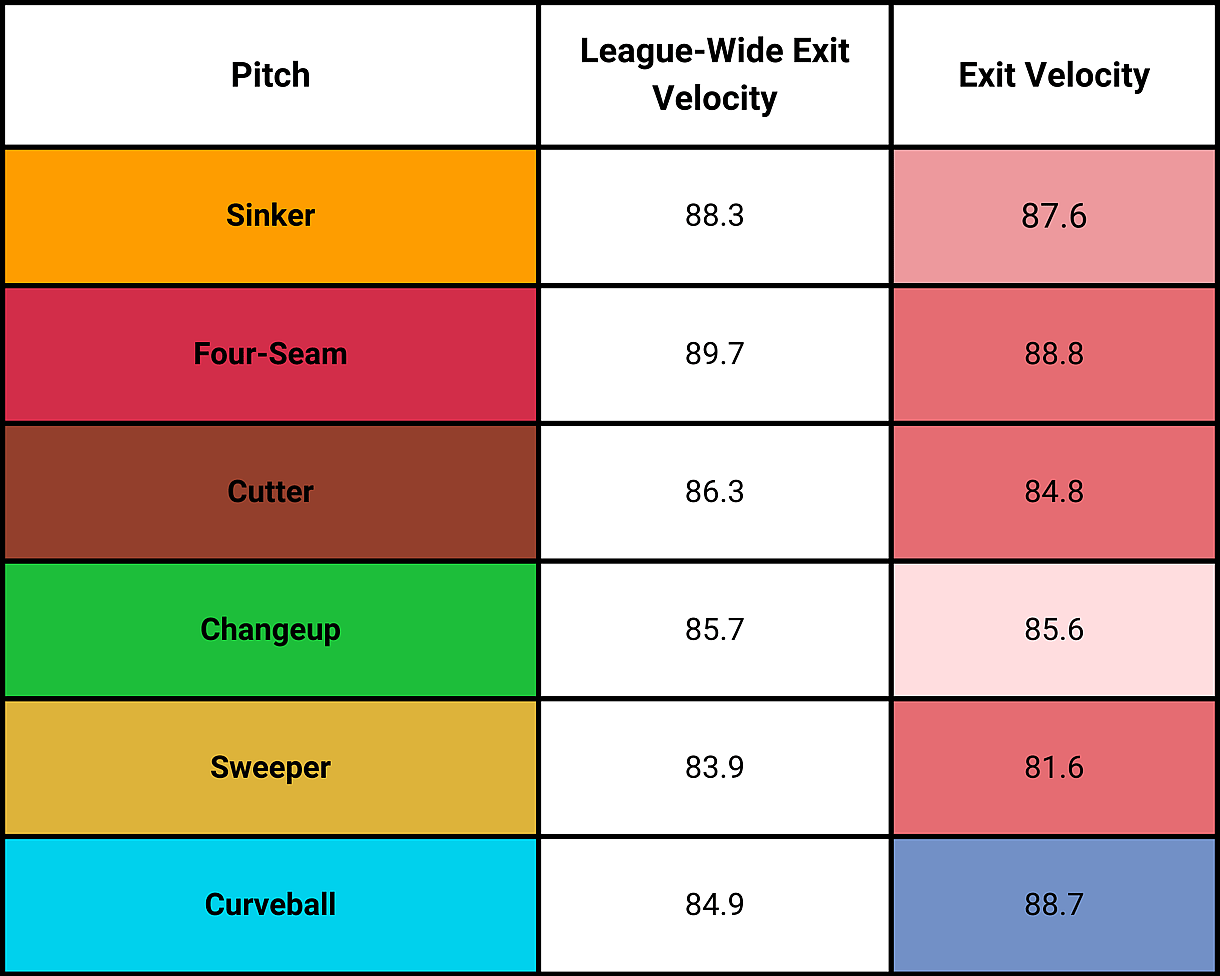
With a 34.8% Hard Hit Rate to boot as well, Vásquez’s above-average pitch shapes also make him tough to generate damage contact on. He struggled with HRs earlier in the season, but he didn’t seem sharp all Spring and could have been just a rust issue, with potentially new baseballs muddying his pitch shapes as well. The Double-A balls are different than the Triple-A ones we’ve seen this year, and the recent stretch he’s on would suggest there have been some adjustments.
From the Yankees’ perspective, the floor here seems to be higher than what Severino provides at this point. Let’s first think of the short-term, which is that the Yankees are three games out from a playoff spot after choosing not to sell or buy at the deadline. “Fire Cashman” chants have hailed from the stands, and Luis Severino was once again blitzed on National Television, this time in a pivotal matchup against the Houston Astros that killed some momentum the Yankees were building.
Randy Vásquez may not be a polished pitcher yet, but projections suggest he could be a serviceable backend starter in the rotation for now, even if it make be a little early for him to earn a full-time spot in the rotation.
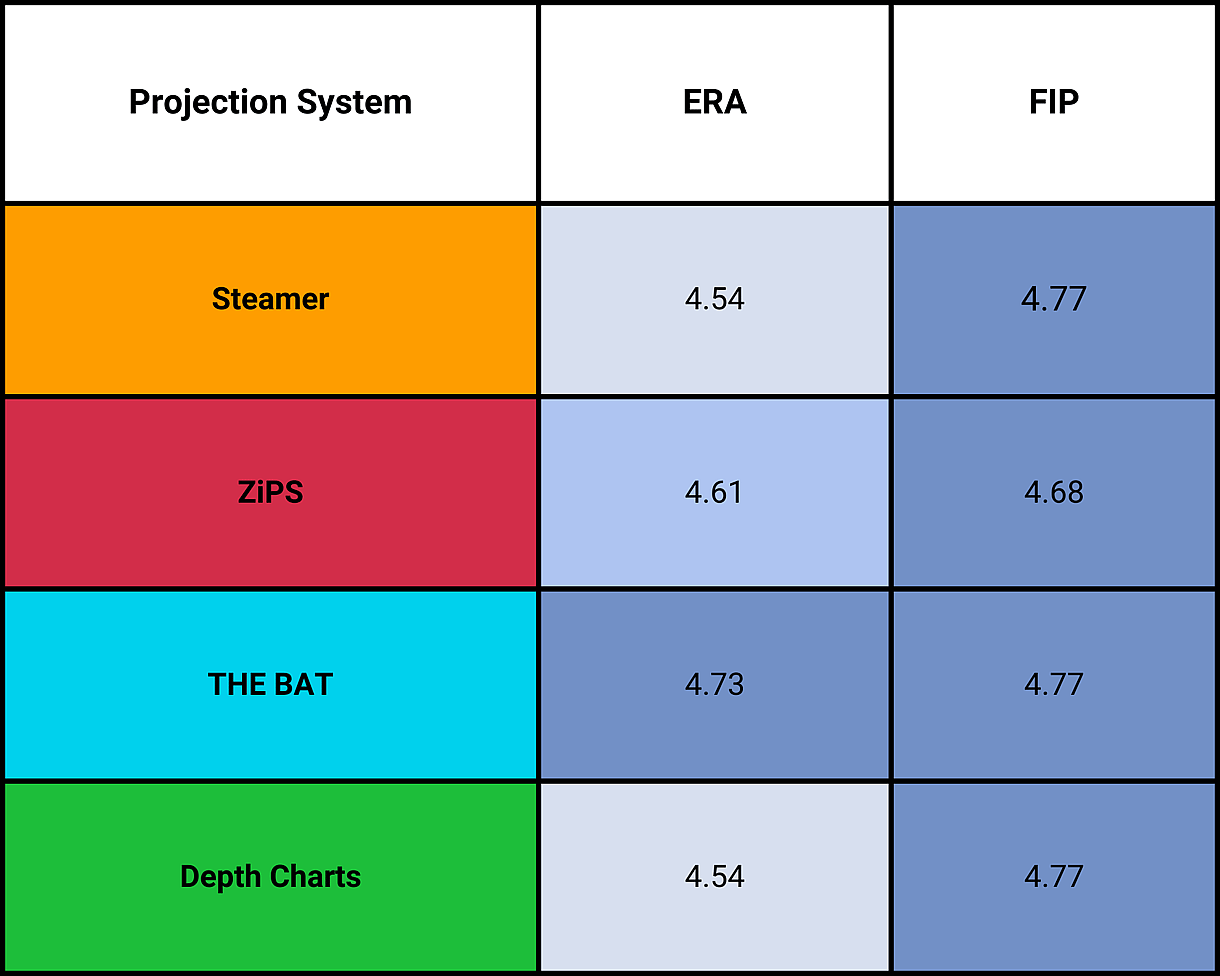
We see that the Yankees are projected to get a slightly below-average starter in run prevention according to Steamer and Depth Charts, with ZiPS having him as slightly worse and THE BAT being the most pessimistic on the right-hander. It’s not great, but it’s significantly better than the ERA north of seven that Luis Severino has provided, and there’s still room for Vásquez to grow in terms of executing two-strike pitches.
There’s a lot for the Yankees to like in this profile, flashing two above-average fastball shapes and an average one with confidence in all three pitches in-zone while possessing a changeup that’s generated high-level results and has plenty of movement and two breaking balls that boast Stuff+ numbers north of 135. If the Yankees and Matt Blake want to see how his results translate to the MLB level, now’s the perfect time, and there’s really not much of a debate for anyone else.
Will Warren isn’t on their 40-Man Roster and hasn’t generated the results he’s looking for quite yet. Clayton Beeter is in a similar boat, still navigating through a crazy run environment and a new baseball. Jhony Brito straight up hasn’t outpitched Vásquez at the MLB or MiLB levels and possesses worse stuff than his younger counterpart, as he’s still developing a sweeping breaking ball to handle right-handed batters.
There’s no telling whether Vásquez will be a positive contributor for the Yankees, but their track record with pitchers is better than people think.

Jordan Montgomery, Luis Severino, and Domingo German are the three most relied-upon starters from that crop of prospects, with the others converting into relievers, being traded, or in some cases, just DFA’d. Jordan Montgomery was an above-average starter over a full season in 2017, 2021, 2022, and 2023, giving his team a chance to win every fifth day and grinding through games in the process.
Domingo German has battled injuries and personal demons that have spilled onto the field, which have muddied his legacy and tenure permanently in New York. He’s had two non-baseball-related incidents end his season, first by violating MLB’s policy on abuse back in 2019 and now a season shut down due to a battle with alcohol addiction. When on the field, he was a solid backend rotation piece for the Yankees and a fine pitcher overall.
As for Luis Severino, we all know the story. An uber-talented pitcher who looked like a Cy Young favorite in 2017 and 2019 before scattering great innings while returning from injuries from 2019-2022 before imploding in 2023. He’s just not the pitcher he was before, but when he was healthy, he was absolutely dominant.
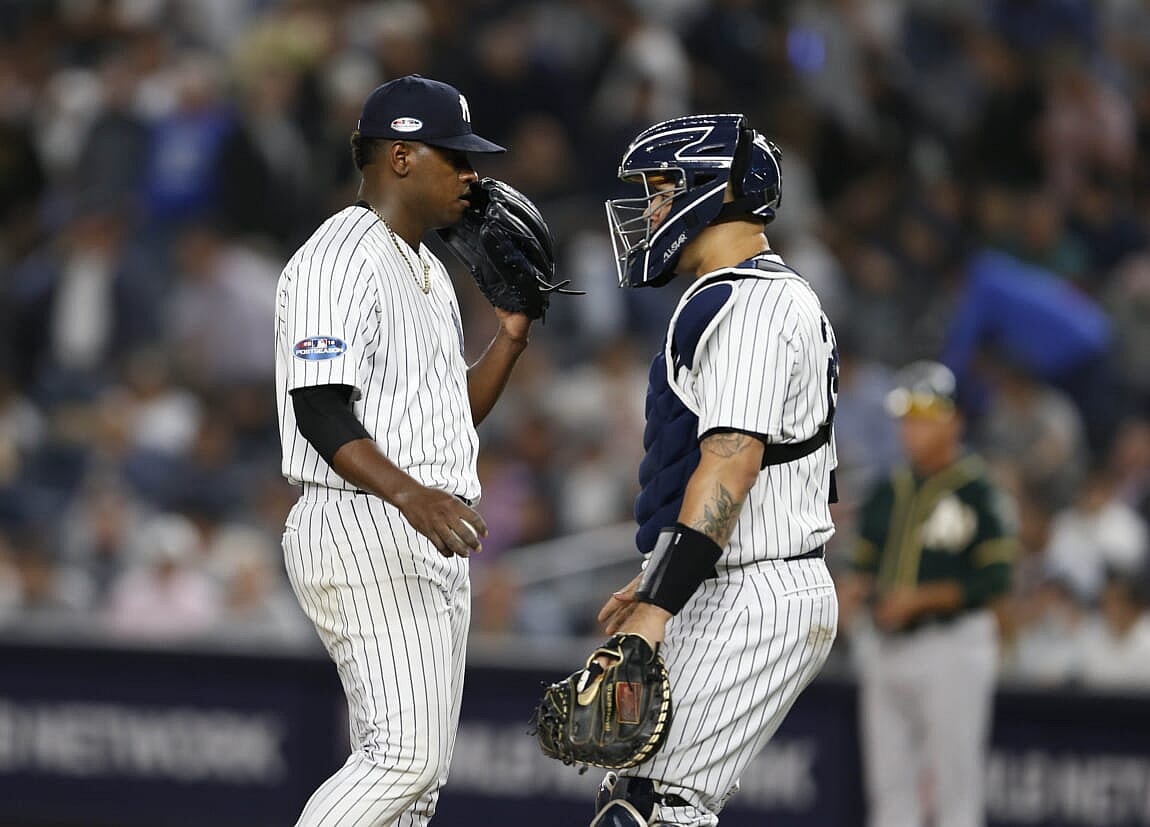
Chad Green and Jonathan Loaisiga both began as starters who then became high-leverage relievers for the Yankees, and with this season looking more like a wash, going for high-risk moves to try to make a push is a sound idea from the Yankees’ side of things. They could see signs they like from Vásquez and either slide him into the bullpen or the rotation, with Severino and Montas entering free agency and opening up rotation spots.
The Yankees’ misfortunes with Severino, Montas, and German this season have really hurt the team, but this could present a golden opportunity for one of the initial pieces of this upcoming crop of prospects. Anthony Volpe is spearheading the charge of prospects brought in at the end of the 2010s and early in 2020 who are starting to reach the higher levels of MiLB. It’s an opportunity to spark some hope among the Yankees’ fanbase, one that’s desperately searching for one.
This season’s dimmed the morale of many in the Yankees’ most devout fan circles, and if they don’t turn things around soon, they’ll miss the postseason and miss out on revenue. Luis Severino doesn’t give the Yankees a chance to win every fifth day, but Randy Vásquez very well can, and that decision happening a week too late could keep the Yankees out of October altogether. Severino got his final shot, now the Yankees have to make the right baseball decision.
It’s almost poetic, as a fiery young pitcher representing a potentially new group of Yankees beginning to reach the big leagues takes over for a struggling Luis Severino, acting as a ray of light that’s peeking through the cracks, a glimpse of brighter days ahead for the New York Yankees.
More about: New York Yankees